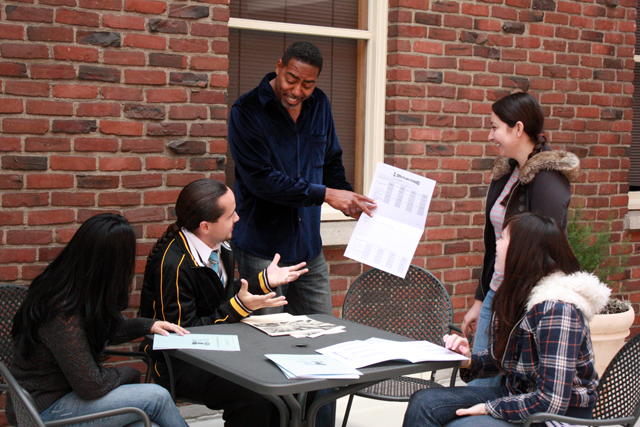Social Networks Study
Preliminary Report from Pilot Survey
September, 2011
The Social Network Study was designed to explore the associations between adolescent peer relationships and group affiliations on the initiation and/or continued use of alcohol and tobacco by adolescents. An important new development in youth culture is the use of social media tools, which may have a profound effect on the nature of these social relationships and therefore also influence behavior. We hope to better understand the role of mobile phone use and Internet social networking sites (SNS) like MySpace or Facebook on the use of tobacco, alcohol and other illegal substances. The results of this study will provide useful information that can either enhance current prevention efforts or inform future program development to incorporate what we have learned about the influences of friends, social norms, and social media use into future programs.
This report summarizes the pilot test results of the survey conducted in the Spring of 2010 at four high schools in the El Monte Union School District of Los Angeles County, Southern California. A total of 1,117 students in the 10th grade participated in this survey. Table 1 presents characteristics of student respondents in our study and compares these to data collected on all students in the United States by the Youth Risk Behavior Survey.
Adolescent Substance Use
Substance use among adolescents (including tobacco, alcohol, illegal drugs such as marijuana, cocaine, ecstasy and others) is particularly worthy of attention because risky behaviors during adolescence are often associated with future delinquent behavior as well as lower grades, higher dropout rates, higher rates of illness, and increasing emergency room and treatment admissions.
Despite a decrease in adolescent smoking between 2002 and 2008, 26% of high school students still use tobacco and 20% smoke cigarettes. The 2010 National Survey on Drug Use and Health reported that drug use increased in 2009, reversing the trends since 2002. There was also a noticeable softening of negative attitudes towards use which has historically been associated with a subsequent increase in rates of use which is evident in the most recent data.
For these reasons, public health researchers have focused their efforts on smoking prevention and cessation interventions for adolescents. Research has begun to incorporate social influences such as peer relationships, friendship networks, and family to determine their effect on substance use behavior.
Social Network Analysis
Social network analysis is used to assess the degree of shared characteristics between individuals who have existing relationships. This type of research has shown that smoking behaviors (both initiation and cessation) can be spread through close and distant social ties, and among friendship groups. Other studies show that peer-to-peer influences among adolescents are an important component for explaining smoking initiation and experimentation. Findings suggest that popular students are more visible and therefore contribute disproportionately to social norms that favor tobacco use, or alternatively, that they experience social pressure to stand out by smoking or by engaging in risky behaviors. An example of this analysis is presented in section V of this report. We can provide these figures for school or district use.
Adolescent Social Media Use
New technologies are transforming the ways in which people access information and maintain social ties. For teens, popular online social networking channels such as MySpace and Facebook provide an outlet for self-expression and social support with peers. Mobile phones are widely used by adolescents for real-time communication with other members in their social network. Despite the surge in adoption of new communication technologies, few studies have examined relationships between media usage and risky behaviors to determine the influence of these technologies on the adolescent substance use.
Preliminary Report
It is likely that Internet activity and mobile phone ownership increases one’s social network size and access to information resources. Perhaps the appeal of social media can be used for health promotion purposes and incorporated into the design of substance prevention/cessation programs that are specifically tailored to adolescent needs and interests.
The remainder of the report is divided into five sections; Section I of this report will summarize findings about adolescent friendships, Section II provides an overview of the most frequently nominated sport activities, clubs and peer groups, Section III reviews the prevalence of SNS and mobile phone use, Section IV will provide an overview of substance use behaviors; and lastly, Section V will provide a sample social network diagram for one class room.
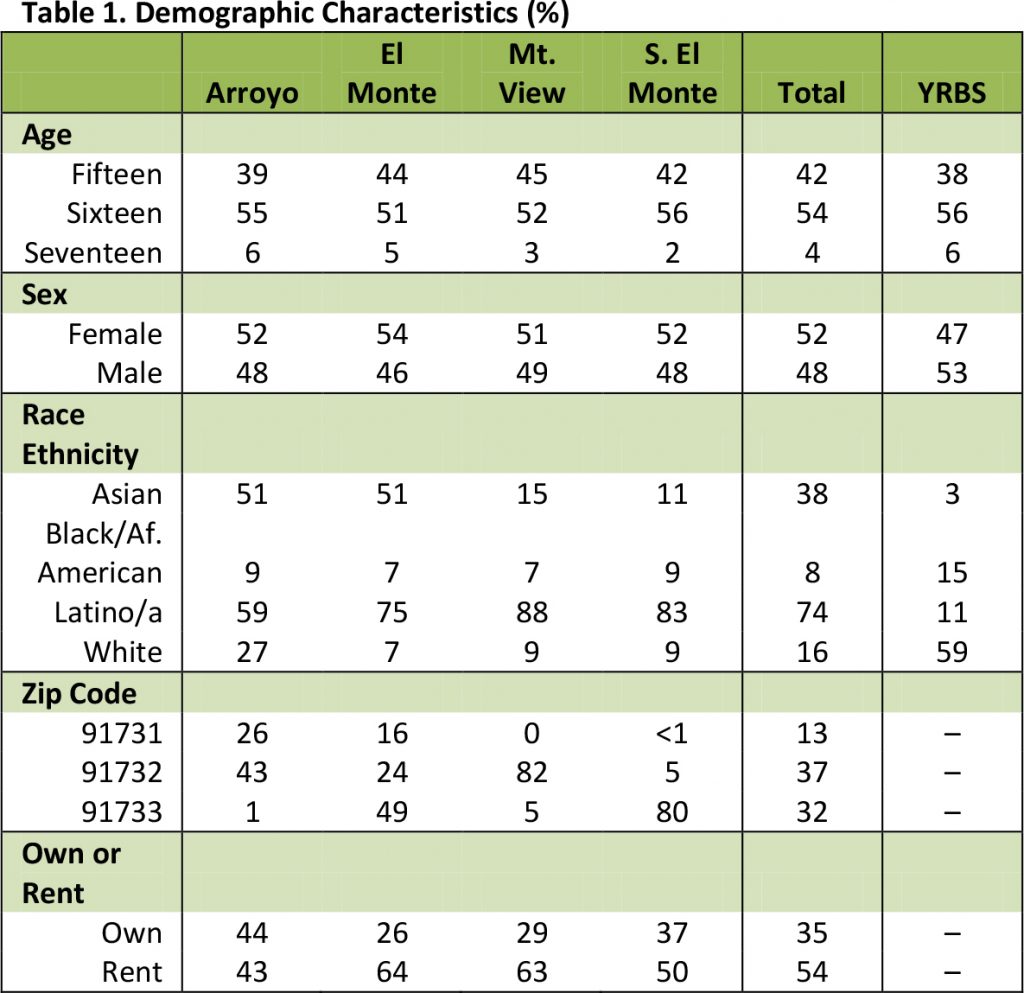
Ethnic Distribution:
In general, the demographic breakdown was similar across the four schools. Most students were either 15 or 16 years old at the time of the survey, with a slightly higher number of females than males. The majority of students reported being Latino/a (74%). Arroyo and El Monte High Schools have a higher representation of Asian students (51%) compared to about 13% Asian students in Mountain View and S. El Monte High Schools. Arroyo High also had the highest representation of White students (27%) compared with the other three schools that have approximately 8% White students.
Compared to national adolescent demographics, the schools that we surveyed are largely overrepresented by students of Latino/a and Asian ethnic backgrounds.
Socioeconomic Information:
Overall, about half of the students (53%) rent their homes from a landlord and 35% own their own homes with an average household income of $32,439. Nearly 15% of residents live below the poverty level. About one-third (36%) of students reported that one or more parent completed high school, and about two-thirds (63%) live with both parents while 18% live with only their mother most of the time. Eighty percent of the students are eligible for free/reduced price lunch at school. These data closely reflect the 2000 Census statistics of El Monte, whereby most residents are Hispanic/Latino (72%) followed by Asians (18%).
Academic Achievement:
Similar to national averages, more than half of students (56%) reported receiving mostly A’s and B’s in the last school year.
Section I. Friendship Networks
Students were asked to name up to five best friends overall, from their classroom, and from the 10th grade. When asked about their best friends, 99.5% of students named at least one and 67% named five best friends. On average, 76% of their best friends attend their own schools and 76% of students reported best friends of the same gender as themselves.
Table 2 (below) lists the percentages of students who nominated at least one and as many as five best friends from their classroom and from the 10th grade, students who are most admired, likely to succeed, popular, and students with whom they wish to have a romantic relationship.
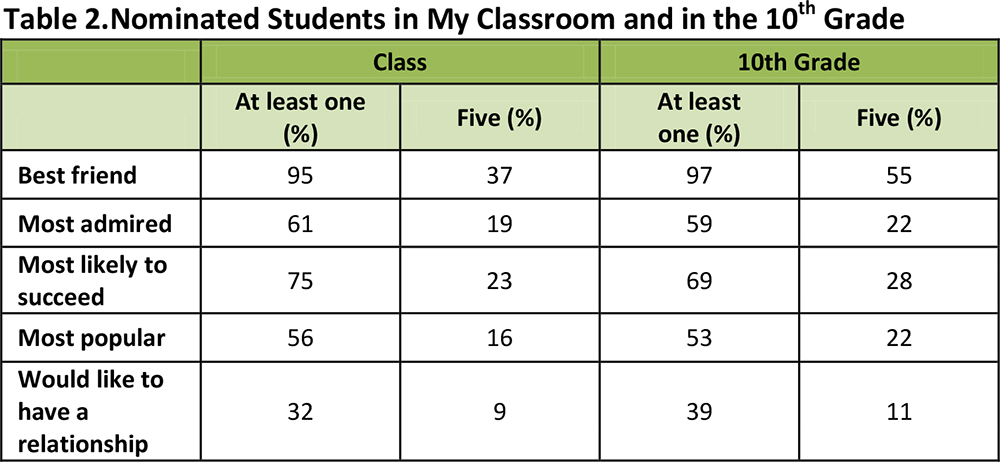
Students indicate that they had a greater number of best friends and were more romantically interested in others from the 10th grade rather than the classroom. About the same number of people were nominated from their classroom as the grade in the other categories.
The characteristics of their five best friends at each of the three levels are summarized in Table 3.
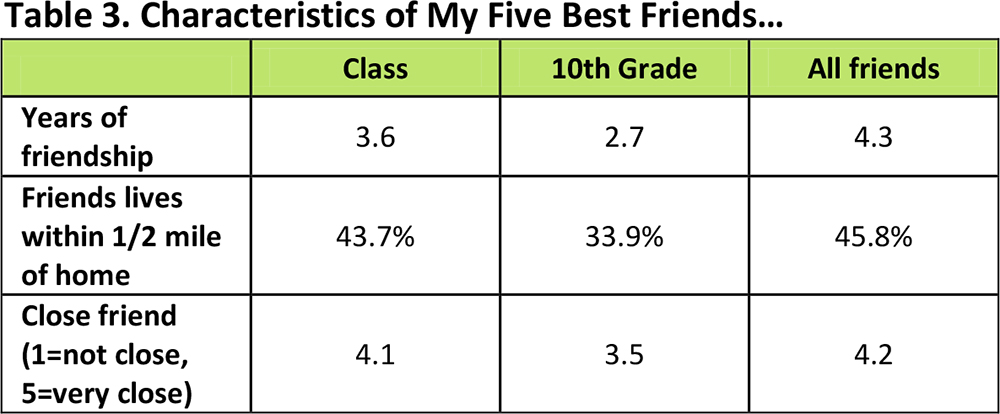
Friendships with classmates are on average about 1 year longer than friendships with best friends in the 10th grade, but friendships beyond their school appear have the longest duration, at 4.3 years. Nearly half of their overall close friends (46%) and close friends within the classroom (44%) live within ½ mile from their home. Friendships are on average closer with overall and classroom friends than with friends from the 10th grade.
Section II. Affiliation Networks
While research has shown that behaviors of best friends is most strongly associated with adolescent smoking, drinking and drug use, there are also studies that suggest that group affiliations are important determinants as well. One finding showed that friendship groups were most influential at the earlier stages of tobacco use, while best friends had greater impact on continued use. This study asks about both friendships as well as the student’s identification with organized or stereotyped groups to better understand the effects of friendship and group identity on adolescent substance use.
Figures 1, 2 and 3 below show the number of times in which specific organized sports, student clubs, and peer groups were nominated for being: popular, admired, likely to smoke or drink alcohol, successful, and most romantically attractive.
Organized Activities
For organized sports, the highest participation among students was in track and field (169), followed by soccer (164), basketball (157), football (146), baseball (90), and tennis (70). Football was most frequently nominated the “most popular” sport, being admired, as well as likely to have students who smoke or drink alcohol. While basketball and soccer where also nominated as being popular and admired, they had less association with delinquent behaviors. Being a part of the track and field team and soccer team was perceived to be most successful. Being a part of the tennis team was perceived as being successful but not perceived as being popular, admired or associated with smoking or drinking.
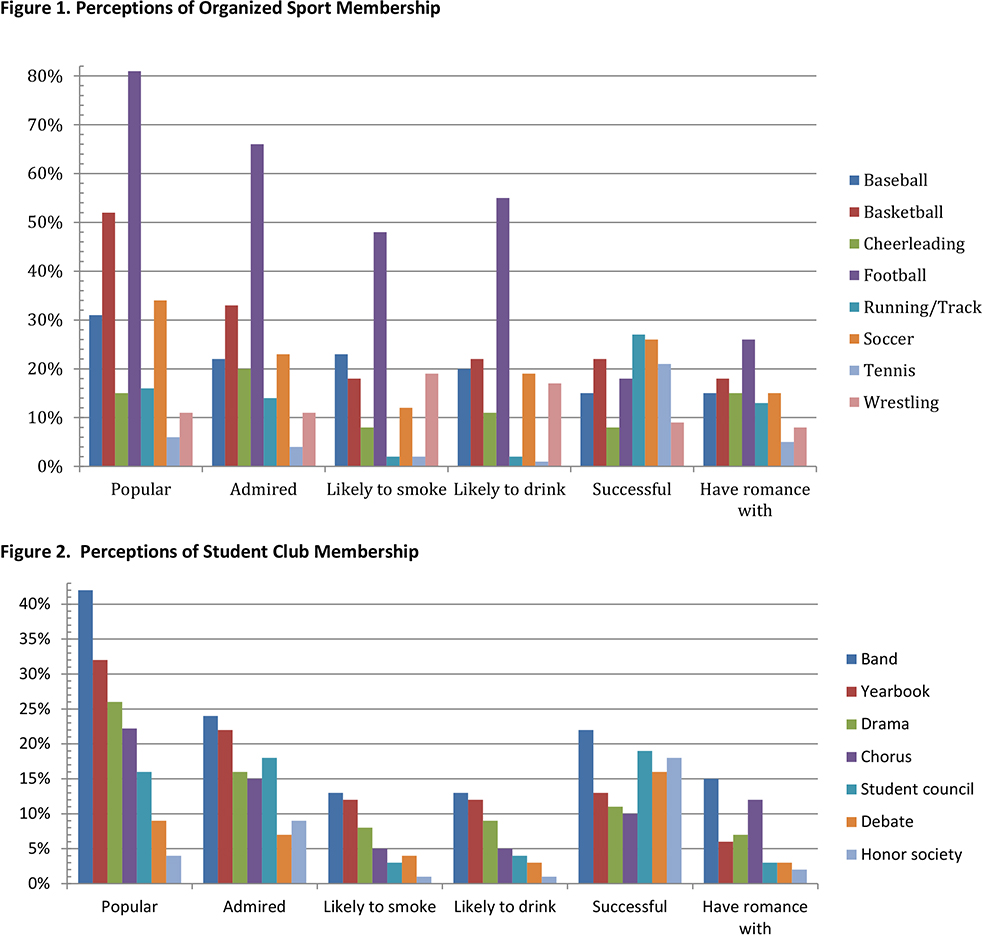
Clubs
In order of highest to lowest participation rates clubs were ranked as follows: the Key Club (49), Chorus/Choir (74), Band (73), California Scholarship Foundation (CSF) (45), French club (41), and Student Council (35). Key Club and CSF were additional clubs that were written in by students, so they are not represented in Figure 2.
Clubs viewed as most popular and most likely to smoke or drink were Band, Yearbook, Drama, and Chorus. Along with Student Council, these clubs were also viewed as most admired. Band, Student Council, Honor Society and Debate clubs were seen as most successful, while Band and Chorus students were most sought after for a romantic relationship.
Groups
Social reputation-based groups have also been shown to be associated with adolescent health-risk behaviors. The reputation of specific groups indicates common attitudes, interests, abilities or behaviors, and may also guide the behavior of those who identify with the group.
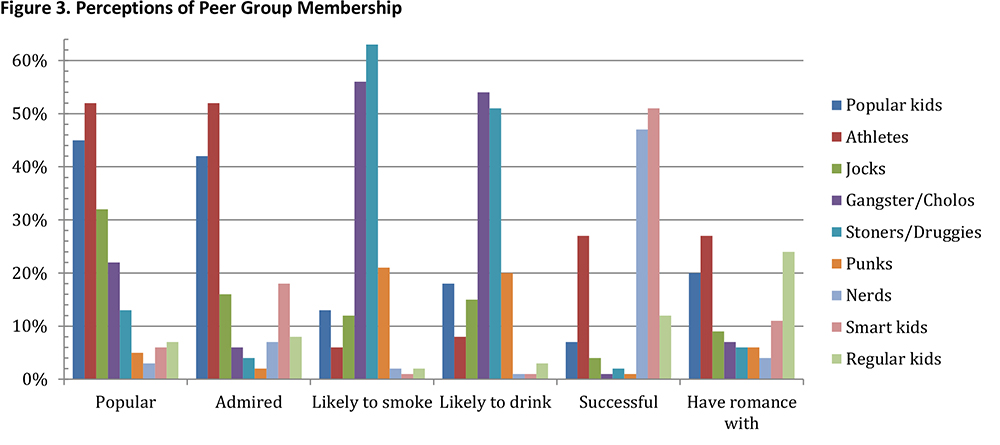
Not surprisingly, regular kids were most endorsed (646) followed by athletes (359), smart kids (279), popular kids (210), gamers (169), nerds (169) and stoners/druggies (148). Groups that were nominated as most popular and most admired were athletes, popular kids, and jocks. Groups that were perceived as most likely to smoke or drink were gangsters and stoners. Smart kids and nerds, who scored low in most other categories, were unanimously nominated as most successful. Romantic relationships were sought with athletes, popular kids and regular kids.
Section III. Social Media Use
Both Internet and mobile phone use have increased dramatically among youth. In the U.S., 93% of adolescents between ages 12-17 access the Internet of these, 73% (82% among 14-17 year-olds) use Social Network Sites such as Facebook or MySpace. Adolescents are also actively engaged in creating their own content online, such as writing their own blogs (52% of U.S. teens).
Given the widespread use of the Internet and mobile technology to connect with others, it is likely that these media channels may play an indirect role in influencing young people’s decision-making and behavioral choices. These online and mobile networks may also increase access to information resources that could potentially be used for health promotion efforts.
Our study results show that nine out of ten students (91%) own at least one computer at home, 84% own at least one video game system, and almost all students owned at least one TV (70% reported owning 3 or more TVs) at home. Eight in ten students (83%) indicated that they have Internet access at home (compared to 96% of teen households in the U.S.). A majority of students (80%) own a cell phone and 3% report sharing one. Of those who own or share cell phone, 86% can text message and half (49%) have Internet access on their phones.
Table 4 shows the frequency that students accessed online social network and gaming sites.
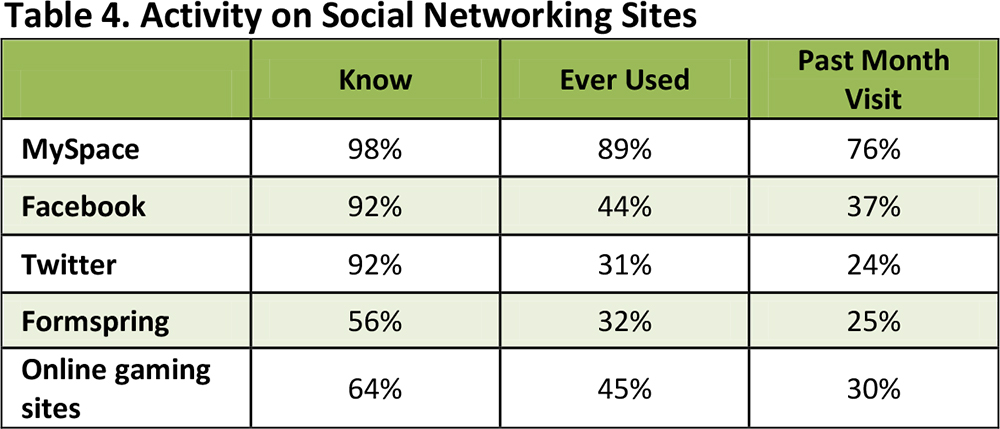
There were no significant gender differences in social media use with 76% of students having visited MySpace in the last month compared to only 37% of students who visited Facebook. Farmville and Mafia Wars were the most popular online games. Other popular sites mentioned were Tumblr and YouTube.
Findings from the pilot survey also revealed the following about the degree of communication with friends through online social networking sites.
- 75% have sent their 5 best friends a message through a social networking site.
- 81% indicate that their best friends are also their friends on MySpace
- 36% indicate that their best friends are also their friends on Facebook
- 16% indicate that they follow their best friends on Twitter
Section IV. Substance Use
Questions used to measure tobacco and alcohol assessed lifetime use (any or ever used in the past), frequency of use in the past month, and current use. Binge drinking is consuming 5 or more drinks at one time.
Table 5 summarizes the social influences and norms associated with smoking and drinking alcohol among adolescents.
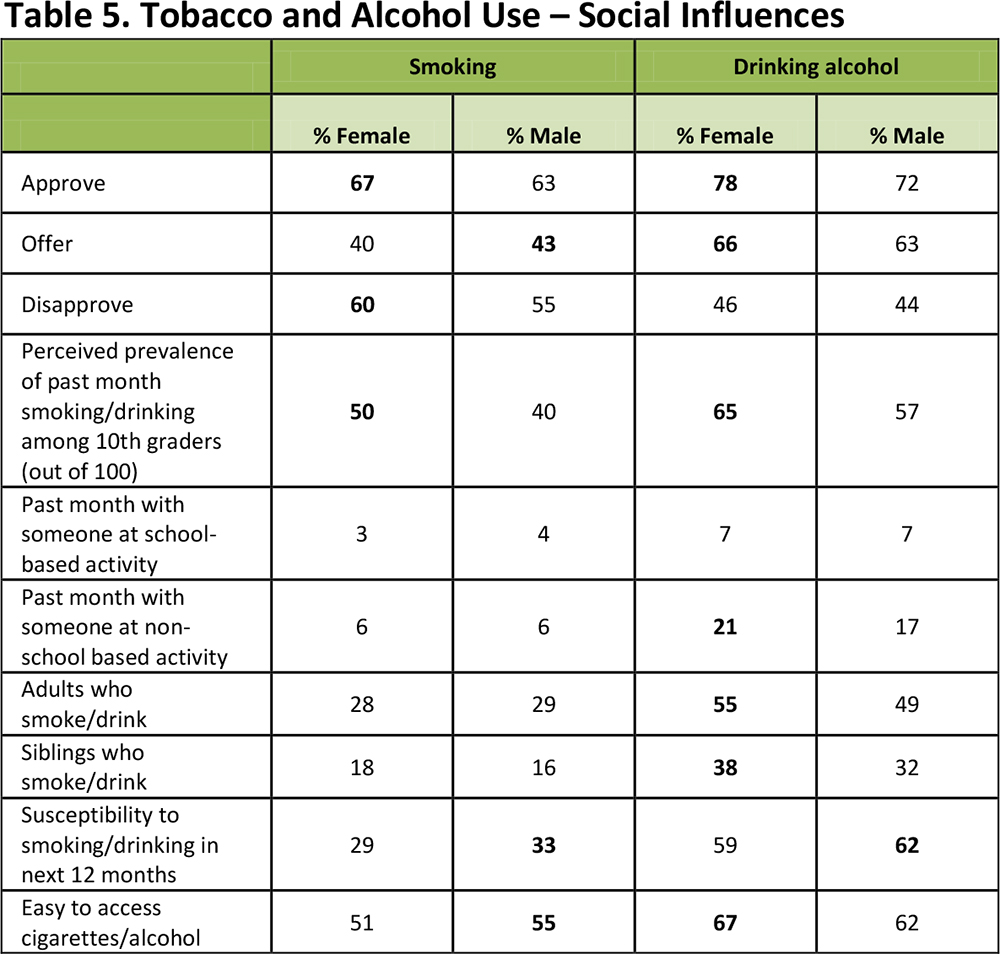
In general, drinking alcohol was perceived more positively than smoking with students also indicating that they are exposed to more adults and siblings who consume alcohol than who smoke. About one-fourth of students reported that their best friends (among the five nominated) smoked a cigarette (22%) and had an alcoholic drink (23%) at least once a month. However, many more students reported actually drinking (20%) compared to smoking (7%) with their best friends. Females appear to have a stronger social influence on each other compared to males in terms of their perceived approval or disapproval. However, males are more like to be offered a cigarette and girls are more likely to be offered a drink.
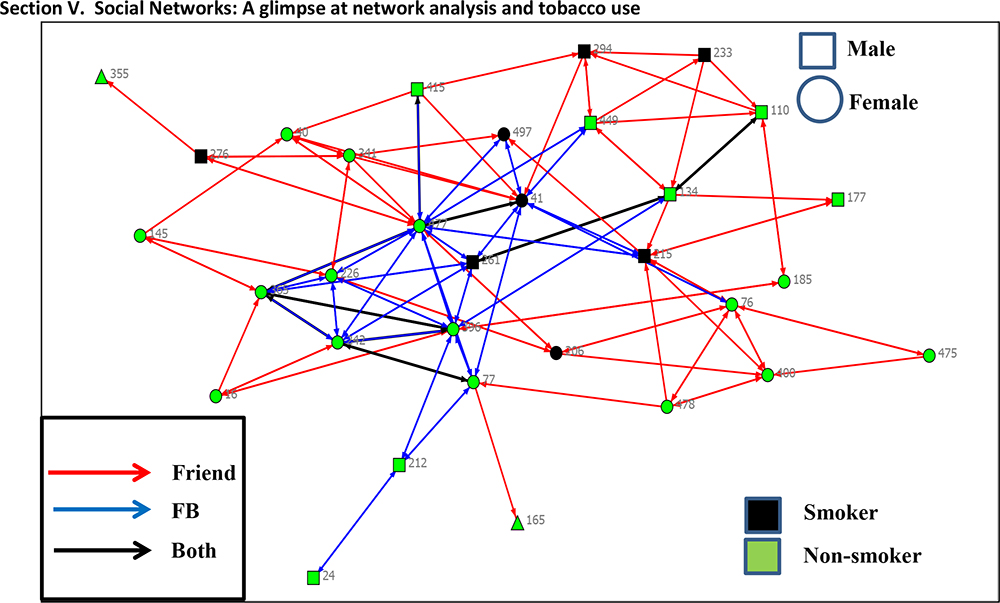
This is a network diagram indicating which students were friends with which other students in one classroom. Each circle or square represents a student and the lines indicate which students named which others as friends. For example, 77 named 165 as a friend, but 165 did not name 77. Student 477 was nominated most frequently as a friend by other students in the classroom. The friendship links are also color coded by relationship type: Red links represent survey nominations, blue links Facebook friendships, and black ones both survey and online. Note there are only five dyads linked both as Facebook and survey friendships (365, 396; 77, 242; 134, 261; 134, 110; 41, 477). Shapes represent sex with circles being female and squares being male. Color represents smoking status, black nodes have smoked at least one cigarette whereas green ones report being non-smokers. Smoking is at a critical point in this class as some prominent and popular students have reported smoking (41 and 261, for example). Student 41 is very popular and often named as a friend so she may be influential in spreading smoking in this class. She is also strongly linked to 477, the most popular student in the class. Student 477 is linked to many others via Facebook and if influence can spread through Facebook smoking may become widespread.
Section VI. Conclusion and Next Steps
The results from this pilot survey have provided an initial overview of the friendships, media use habits and substance use behaviors among the adolescents in the El Monte School District. We look forward to collaborating with the district and individual schools to provide whatever data or analyses that could be useful in any way.
From the next waves of data we will discover what types of group affiliations and friendship types are most associated with the initiation of alcohol and tobacco use. We will also learn whether friendships are formed on the basis of similar behaviors or whether behaviors change according to friendship types. Similarly, we wish to explore how virtual friendships formed on social network sites differ from those formed in-person or whether there is substantial overlap between them. And lastly, we aim to explore how friendship networks are tied to social identity and beliefs about substance use. Examining these questions will enable researchers and educators to address the needs of students and communities and direct their efforts towards the promotion of healthy attitudes and behaviors regarding substance use.
Contact Information

Thomas William Valente, PhD
Professor of Preventive Medicine
Interim Chair of Preventive Medicine
tvalente@usc.edu

Daniel Soto, MPH
Project Manager Professor, Preventive Medicine
Project RED, SNS, and COPAL
danielws@usc.edu
Resource Links
For more information about school clubs and sports, check out these great articles:
- PBS Kids: Get Extra-Curricular
- Teen Health: Benefits of Extracurricular Activities
- Teen Health: Choosing the Right Sport
And for more information on applying to college and choosing a career:
Career One Stop
Match your interest with a career
College.gov
An interactive website that answers questions about college
Teen Ink
List of different volunteer, college and career resources
For more information about teen alcohol and drug use:
NIDA for Teens
Science-based facts about how drugs affect the brain and body
The Cool Spot
Interactive site for resisting peer pressure
Smoke Free Teen
Great tools to quit smoking for teens
Smoke Free Text
Text for 24/7 encouragement, advice, and tips to help smokers stop smoking for good

